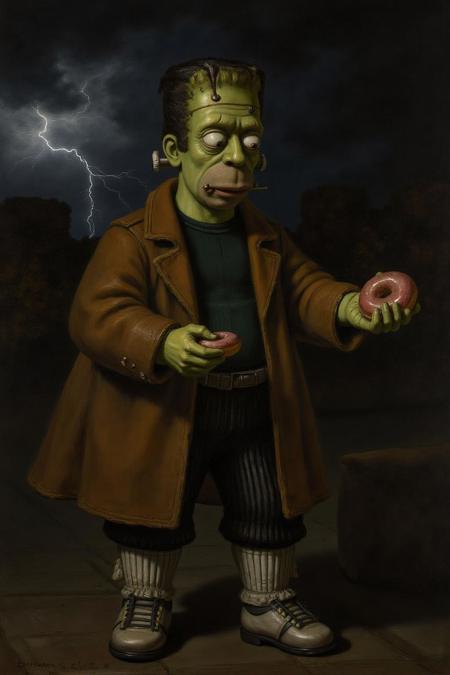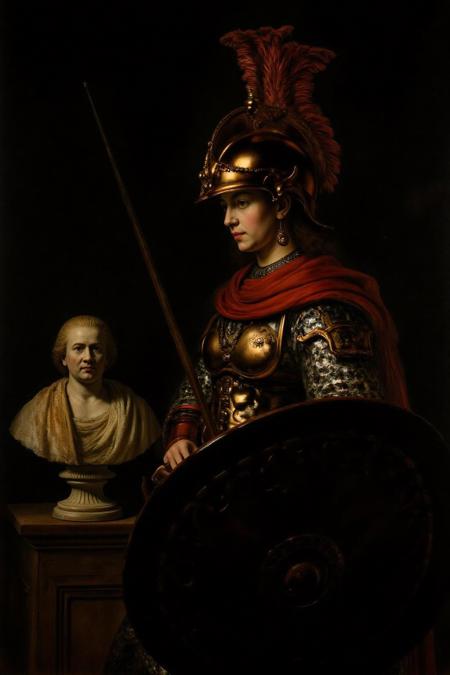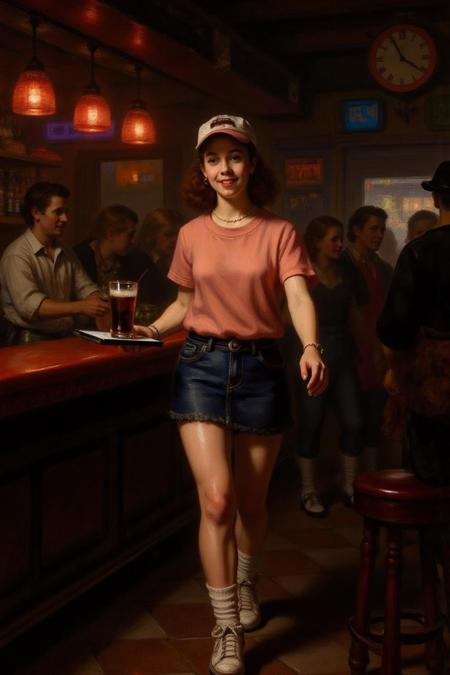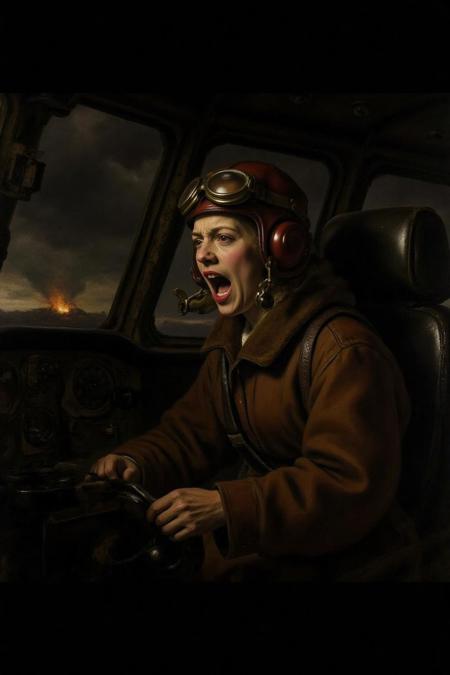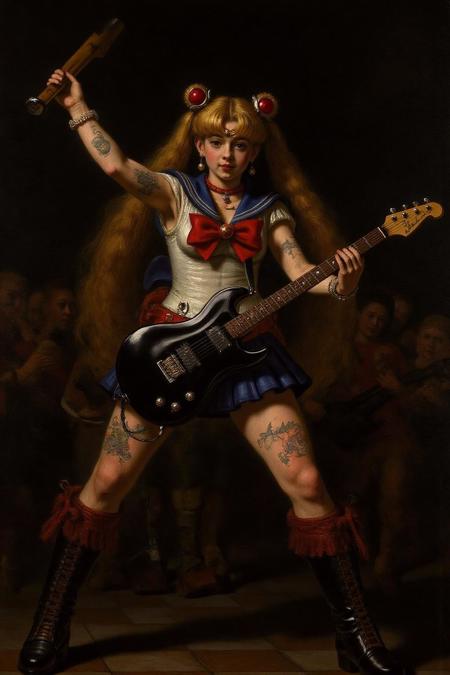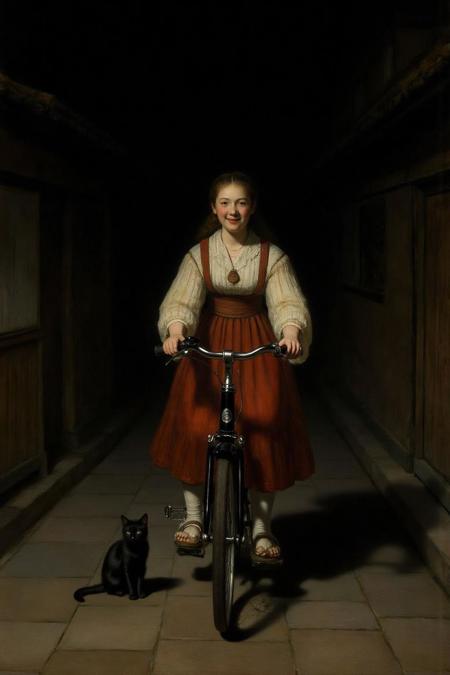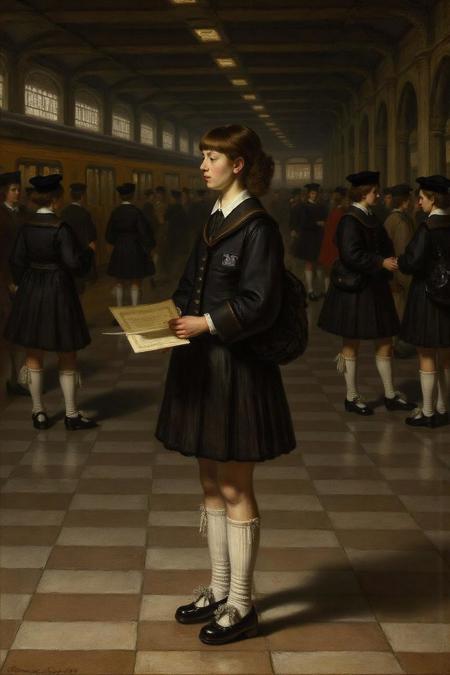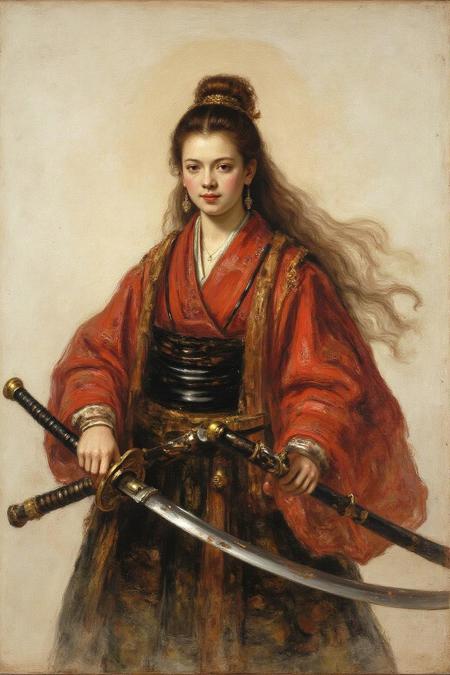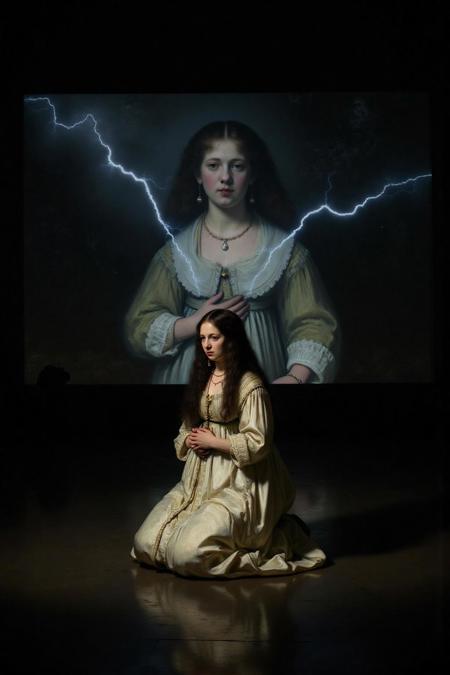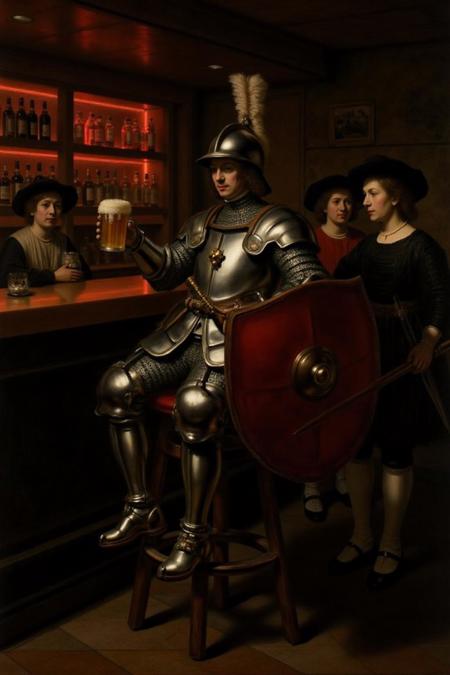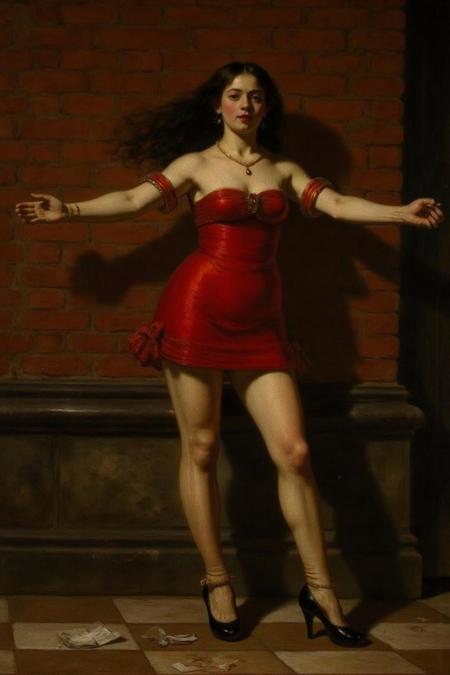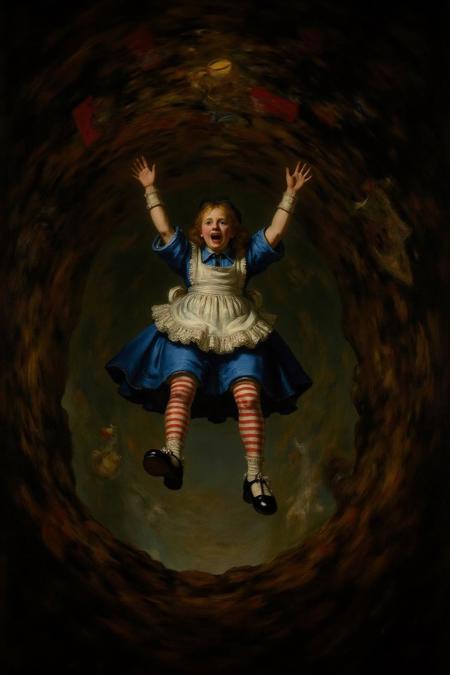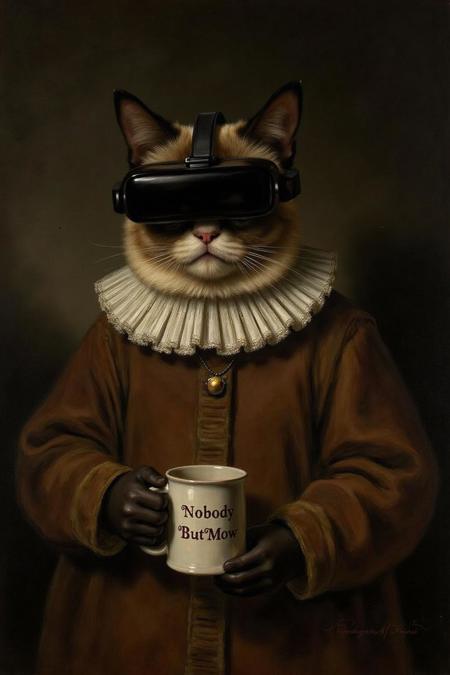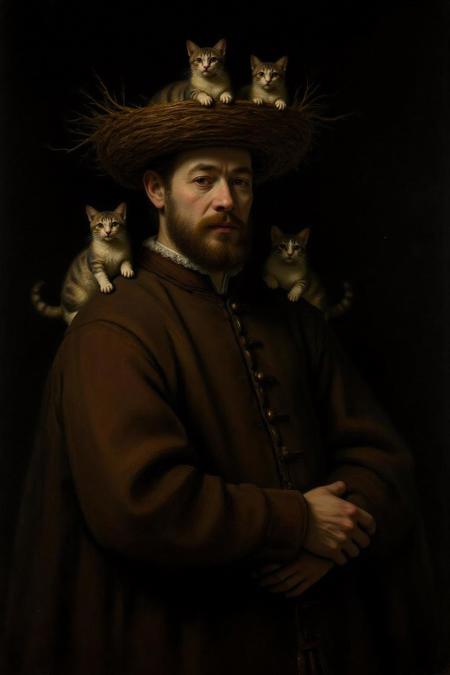
This is the 2nd Rembrandt LoRA, which compliments my earlier Rembrandt Etching Style LoRA. This LoRA was trained mostly with Rembrandt's later period oil painting portraits. His famous large scale works such as The Anatomy Lesson of Dr. Nicolaes Tulp (1632) and The Night Watch (1642) were not used. The Jewish Bride (c. 1667) is in the training set, though.
Rembrandt oil paintings are renowned for his use of chiaroscuro. His mastery of light and shadow created dramatic contrasts, drawing the viewer’s attention to key elements of his compositions.
Rembrandt Harmenszoon van Rijn needs little introduction. Unlike the other two masters in the series, Rembrandt has explorered many subjects and medias throughout his illustrious and long career. For this reason, I will be training at least two LoRAs for his style, starting with this etching style LoRA.
Like most Flux LoRA, the training trigger "rembr2 painting" is actually not required, but it does make your intentions clearer. You do have to tell Flux to generate "painting/oil painting/etching/sketch/drawing" for some prompts to steer it away from its default photo style.
Have fun with the LoRA. If you post your first image directly here (click on "Add Post" above the gallery), I will give you 10 buzz for that image ? (If I forgot, just complain loudly ?)
This is what ChatGPT has to say about Rembrandt.
Rembrandt Harmenszoon van Rijn (July 15, 1606 – October 4, 1669) was a Dutch painter, printmaker, and draughtsman who is widely regarded as one of the greatest and most influential artists in history. Renowned for his innovative use of light and shadow, psychological depth, and ability to convey emotion, Rembrandt was a central figure of the Dutch Golden Age of painting.
Early Life and Training
-
Birth and Family:
-
Rembrandt was born in Leiden, Netherlands, into a relatively prosperous family. His father was a miller, which afforded him access to a good education.
-
-
Education and Training:
-
He attended Latin school and briefly enrolled at Leiden University but soon pursued art full-time.
-
He apprenticed with local painters and later studied under Pieter Lastman in Amsterdam, who introduced him to the dramatic storytelling techniques of history painting.
-
Artistic Career
Rembrandt’s career can be divided into three phases: his early years in Leiden, his successful period in Amsterdam, and his later years marked by financial difficulties and personal tragedies.
-
Leiden (1625–1631):
-
During this period, Rembrandt created small history paintings and portraits. He began experimenting with dramatic lighting and compositions.
-
-
Amsterdam and Success (1631–1650):
-
Rembrandt moved to Amsterdam, where he gained fame and prosperity as a portrait painter.
-
His commissioned group portrait, The Anatomy Lesson of Dr. Nicolaes Tulp (1632) solidified his reputation.
-
He married Saskia van Uylenburgh, whose dowry supported his thriving studio.
-
His innovative use of chiaroscuro (contrast between light and shadow) reached new heights during this time.
-
Notable works: The Night Watch (1642) and The Jewish Bride (c. 1667).
-
-
Later Years and Challenges (1650–1669):
-
After Saskia's death, Rembrandt faced personal and financial difficulties, including bankruptcy. He maintained a modest lifestyle but continued to produce deeply moving works.
-
Despite his hardships, his later paintings, such as The Return of the Prodigal Son (1669), exhibit profound emotional and spiritual depth.
-
He lived with his companion, Hendrickje Stoffels, and their daughter, Titus, during this period.
-
Artistic Style and Innovations
-
-
Rembrandt’s mastery of light and shadow created dramatic contrasts, drawing the viewer’s attention to key elements of his compositions.
-
-
Psychological Depth:
-
His portraits and self-portraits are renowned for their ability to capture the inner lives and emotions of their subjects. His self-portraits, spanning over four decades, offer a deeply personal chronicle of his life.
-
-
-
Rembrandt revolutionized the medium of etching, achieving incredible tonal range and detail. His etchings, such as Hundred Guilder Print (c. 1649), remain some of the finest examples of the technique.
-
-
Humanity in Art:
-
Unlike many of his contemporaries, Rembrandt often depicted biblical and historical figures with raw humanity, making them relatable and emotionally resonant.
-
Famous Works
-
The Night Watch (1642) :
-
A large group portrait of a civic guard company, famous for its dramatic use of light and movement.
-
-
The Anatomy Lesson of Dr. Nicolaes Tulp (1632):
-
A groundbreaking portrayal of a public anatomy lesson, showcasing his innovative composition.
-
-
-
Over 80 self-portraits chart his development as an artist and his personal journey through triumph and tragedy.
-
-
The Return of the Prodigal Son (c. 1669):
-
A deeply spiritual work that conveys forgiveness and compassion through subtle yet powerful imagery.
-
Legacy
-
Artistic Influence:
-
Rembrandt's innovative techniques and emotional depth influenced countless artists, including Vincent van Gogh and the Impressionists.
-
-
Cultural Significance:
-
He is celebrated as a symbol of the Dutch Golden Age, embodying its artistic and cultural achievements.
-
-
Recognition:
-
Today, Rembrandt is regarded as one of the greatest artists in Western art history, and his works are housed in major museums worldwide, including the Rijksmuseum in Amsterdam.
-
Personal Life and Death
Rembrandt’s life was marked by great success but also deep personal loss, including the deaths of his wife Saskia, his children, and later his companion Hendrickje. Despite his financial struggles in his later years, he continued to create art that is unparalleled in its emotional and technical mastery. He died in 1669 and was buried in an unmarked grave in Amsterdam.
描述:
This LoRA was trained without detailed captioning. Most of the caption is just "oil painting of a man/woman". Except for 4 images that are described in more detail to "help" the trainer.
This is epoch 10, the rest can be found here tensor. art/models/812148792339084539/Rembrandt-Painting1-SemCD6Cos5-2024-12-28-03:41:14-Ep-10
FLUX.1 - dev-fp8
Trigger: rembr2 painting
Repeat: 20 Epoch: 10 (Trained on 19 512x512 images for total of 3800 steps)
Unet LR: 0.0005 Scheduler: cosine Optimizer: AdamW
Network Dim: 6 Alpha: 3
-
Epoch Loss
-
1 0.342
-
2 0.334
-
3 0.334
-
4 0.330
-
5 0.313
-
6 0.309
-
7 0.299
-
8 0.288
-
9 0.292<-
-
10 0.278 <- lowest
训练词语: rembr2 painting
名称: Rembrandt.v1.painting.edited.512.zip
大小 (KB): 556
类型: Training Data
Pickle 扫描结果: Success
Pickle 扫描信息: No Pickle imports
病毒扫描结果: Success
名称: rembr_paint1_semicap_d6a3.safetensors
大小 (KB): 56202
类型: Model
Pickle 扫描结果: Success
Pickle 扫描信息: No Pickle imports
病毒扫描结果: Success

